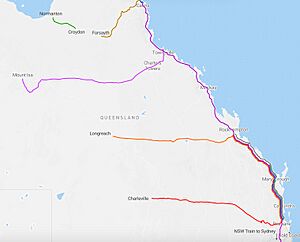Queensland Rail facts for kids
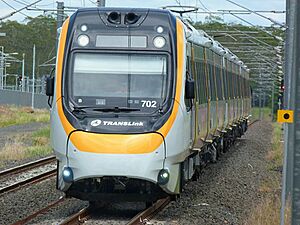
New Generation Rollingstock
|
|
| Industry | Railway operator |
|---|---|
| Founded | 31 July 1865 |
| Headquarters |
Brisbane, Queensland
,
Australia
|
|
Area served
|
Queensland |
|
Key people
|
Katarzyna Stapleton (CEO) |
| Revenue | $2.3 billion (2021/22) |
|
Operating income
|
$392 million (2021/22) |
| $195 million (2021/22) | |
| Owner | Queensland Government |
|
Number of employees
|
over 7,500 (Feb 2022) |
Queensland Rail (often called QR) is a company that runs trains in Queensland, Australia. The Queensland Government owns Queensland Rail. It operates trains for people traveling short distances in South East Queensland. It also runs longer trips connecting Brisbane to other parts of Queensland. Queensland Rail also owns and takes care of the trains themselves. They also look after about 6,600 kilometres (4,101 mi) of railway tracks and other important railway structures.
Contents
History of Queensland Rail
How Queensland Railways Started
Queensland Railways was the first in the world to use a narrow gauge for its main railway lines. This means the tracks were closer together than usual. The gauge they chose was 1,067 mm or 3 ft 6 in, and it's still used across Queensland today.
The area of Queensland became a separate colony from New South Wales in 1859. The new government wanted to help the region grow and bring in more people. Improving transport to the rich farming area of Darling Downs was a top goal. This area is west of Toowoomba.
Since boats already traveled between Brisbane and Ipswich, the railway started from Ipswich. The first part of the line opened on July 31, 1865, going to Bigge's Camp. This part was mostly flat and easy to build. The only big construction was a bridge over the Bremer River.
Building tunnels through the Little Liverpool Range took time. This delayed the next section to Gatton by 10 months. But the line reached Toowoomba in 1867. The narrow gauge was chosen because it was easier to build tracks up the steep Main Range.
A private company had planned to build a wider, horse-drawn tramway. But they couldn't get enough money. So, the Queensland Government built the railway instead. They used the 1,067 mm (3 ft 6 in) gauge, which was unusual then.
Choosing a narrow gauge was a big discussion at the time. The government wanted to build the railway as fast and cheaply as possible. Narrower tracks allowed for sharper curves and lighter trains. This made construction less expensive. It was estimated that a narrow gauge line from Ipswich to Toowoomba would cost only 25% of a standard gauge line. This made sense for a new colony with a small population.
Over time, the railway network grew as separate sections. It wasn't until December 1924 that all these sections were connected. The only exception was the Normanton to Croydon line, which always stayed separate. At its largest in 1932, the network had 10,500 kilometres (6,524 mi) of tracks.
Later, many smaller railway lines were closed starting in 1948. This was because transport methods changed. However, the main lines were improved to offer modern services. From the 1970s, many new lines were built, especially to serve coal mines.
Making Trains Electric

In November 1979, the Brisbane suburban train network became electric. This meant trains could run on electricity instead of diesel.
In 1978, people started talking about making the coal train networks electric too. These were in areas like Blackwater and Goonyella. They expected more coal to be transported. Also, their diesel trains were getting old, and diesel fuel was becoming more expensive. By early 1983, the decision was made to electrify these networks. Contracts for new electric trains and other work began in early 1984. They decided to use the same 25 kV AC railway electrification system as the Brisbane network. This would allow the Brisbane network to connect with the coal networks later.
The project was planned in four steps:
- Step 1: Electrifying the main line from Gladstone to Rockhampton. This included parts of the Rockhampton train yard. Then, it went west to Blackwater and the coal mines there. This covered 720 kilometres (447 mi) of track.
- Step 2: Electrifying the coal lines south of Dalrymple Bay and Hay Point. Then, it went west through the Goonyella system. It also went southwest to Blair Athol and south to Gregory. This connected the Goonyella system to the Blackwater system. This covered 773 kilometres (480 mi) of track.
- Step 3: Electrifying the main western line from Burngrove to Emerald. This would allow electric freight trains to travel from Rockhampton to Emerald.
- Step 4: This step was originally planned for the line from Newlands coal mine to Collinsville and northeast to Abbott Point. However, this stage did not happen. Instead, in 1986, they decided to electrify the North Coast line between Brisbane and Gladstone. This became known as Stage 4.
Expanding Freight Services
In September 1999, Queensland Rail changed its name to QR. In March 2002, QR bought another railway company called Northern Rivers Railroad. They renamed it Interail. This helped QR achieve its goal of expanding its services beyond Queensland.
In March 2003, QR started moving coal in the Hunter Valley Coal Chain area. Interail began a contract to transport coal from Duralie Colliery to Stratford Mine. Another coal contract was won in late 2003. This was for moving coal from Newstan Colliery to Vales Point Power Station. In 2004, Interail started running services that carried goods between Brisbane and Melbourne, and between Sydney and Melbourne. In June 2005, Queensland Rail bought the CRT Group.
In June 2006, QR also bought the Western Australian part of the Australian Railroad Group.
Changes and New Ownership
QR used to handle all freight services in Queensland. From 2002, it also ran services between states under different names like Australian Railroad Group, Interail, and QR National. In July 2010, these freight services were separated into a new company called QR National. This company was later sold to private owners and is now known as Aurizon.
In June 2009, the Queensland Government announced that it would sell off Queensland Rail's freight business. This meant that Queensland Rail's freight trains and other assets were moved to QR National (now Aurizon) starting from July 1, 2010.
In April 2013, the Queensland Parliament passed a new law. This law changed how Queensland Rail was structured. The old Queensland Rail Limited company stayed, but it became part of a new group called the Queensland Rail Transit Authority (QRTA). This meant that Queensland Rail Limited was now a subsidiary of QRTA. The staff were also moved to the QRTA. This change meant the government had more control over how employees worked. However, in November 2013, five worker unions took legal action. They argued that QRTA should follow federal industrial laws, not state laws. In April 2015, the court decided that QRTA was indeed under federal law.
Leaders of Queensland Rail
Commissioners
Here are some of the people who led Queensland Railways as Commissioners:
- December 23, 1863 – October 1864: Abraham Fitzgibbon
- October 28, 1864 – April 29, 1869: Arthur Orpen Herbert
- July 15, 1870 – March 12, 1885: Arthur Orpen Herbert
- March 12, 1885 – July 29, 1889: Francis W. Curnow
- July 29, 1889 – June 30, 1896: John Mathieson (Chief Commissioner)
- July 29, 1889 – September 1895: Robert John Gray (1st Assistant Commissioner)
- July 29, 1889 – December 13, 1894: Andrew Johnston (2nd Assistant Commissioner)
- July 1, 1896 – September 30, 1902: Robert John Gray
- November 5, 1902 – March 24, 1911: James Forsyth Thallon
- March 30, 1911 – May 31, 1911: Thomas Mulhall King
- June 1, 1911 – October 31, 1918: Barnard Charles Evans
- November 1, 1918 – February 28, 1938: James Walker Davidson
- March 1, 1938 – February 28, 1941: Curteis Anthony Murton
- March 9, 1941 – February 27, 1948: Percy Robert Turner Wills
- March 1, 1948 – August 31, 1952: Timothy Edward Maloney
- September 1, 1952 – August 31, 1962: Gerald Vincent Moriarty
- September 1962 – July 4, 1976: Alva George Lee
- July 5, 1976 – December 17, 1982: Percy James Goldston
- January 13, 1983 – April 1986: Douglas Vernon Mendoza
- May 20, 1986 – July 31, 1989: Ralph T. Sheehy
- August 1, 1989 – December 1989: Ross William Dunning
- December 1989 – October 7, 1990: Robin G. Read (Acting Commissioner)
- October 8, 1990 – June 30, 1991: Vincent John O'Rourke
From July 1, 1991, the role of Commissioner for Railways changed. It was replaced by a Chief Executive Officer (CEO) who reported to a board of directors.
Chief Executive Officers (CEOs)
| Name | Time in Role | Notes |
|---|---|---|
| Vincent John O'Rourke | July 1991 – December 2000 | |
| Bob Scheuber | December 2000 – April 2007 | |
| Stephen Cantwell | April 2007 – November 2007 | |
| Lance Hockridge | November 2007 – June 30, 2010 | |
| Paul Scurrah | July 1, 2010 – December 2, 2011 | Became CEO after the new Queensland Rail company was formed. He was previously a manager for QR Passenger. |
| James Benstead | December 2011 – August 2013 | |
| Glen Dawe | August 2013 – January 2014 | |
| Helen Gluer | April 3, 2014 – October 27, 2016 | |
| Neil Scales | October 2016 – March 2017 | |
| Nick Easy | March 2017 – December 2021 | |
| Katarzyna (Kat) Stapleton | April 2022 – present |
Queensland Rail Services
Trains in South East Queensland
Queensland Rail runs city and interurban train services in South East Queensland. These are part of the Translink network. There are twelve train lines: Airport, Beenleigh, Caboolture, Cleveland, Doomben, Ferny Grove, Gold Coast, Ipswich/Rosewood, Redcliffe Peninsula, Shorncliffe, Springfield, and Sunshine Coast. Queensland Rail uses different types of electric trains for these services. These include the Suburban Multiple Unit (SMU), Interurban Multiple Unit (IMU), and New Generation Rollingstock (NGR) trains.
Long-Distance Train Journeys
Queensland Rail offers five long-distance passenger train services. These are known as Queensland Rail Traveltrain:
- Tilt Train: Travels from Brisbane to Rockhampton.
- Spirit of Queensland: Travels from Brisbane to Cairns.
- Spirit of the Outback: Travels from Brisbane to Longreach.
- Westlander: Travels from Brisbane to Charleville.
- Inlander: Travels from Townsville to Mount Isa.
They also have bus services that connect to these trains. In 2022–23, about 690,000 people used these long-distance travel and tourism services.
Fun Tourist Trains
Queensland Rail also operates two special tourist train services:
- Gulflander: Travels on the Normanton to Croydon route.
- Kuranda Scenic Railway: Travels from Cairns to Kuranda.
Past Train Services
Queensland Rail used to run many other named trains, including:
- Capricornian: Ran from Brisbane to Rockhampton from 1970 to 1993. It was replaced by the Spirit of the Outback.
- Great South Pacific Express: A luxury train that ran from Kuranda to Sydney from 1999 to 2003.
- The Midlander: Ran from Rockhampton to Winton from 1954 to 1993. It was also replaced by the Spirit of the Outback.
- Savannahlander: Ran from Cairns to Forsayth from 1995 to 2004. A private company now operates it.
- Spirit of Capricorn: Ran from Brisbane to Rockhampton from 1988 to 2003.
- The Sunlander: Ran from Brisbane to Cairns from 1953 to 2014. It was replaced by the Spirit of Queensland.
Queensland Rail's Trains and Locomotives
In 1936, Queensland Rail owned a large number of trains. This included 750 locomotives (the engines that pull trains), 67 railcars, and many passenger and goods wagons.
Queensland Rail bought its steam locomotives from many different companies. These companies were from the United Kingdom, the United States, and Australia. They also built some locomotives themselves at the North Ipswich Railway Workshops.
Diesel trains started to be used in 1952. Early diesel locomotives were bought from companies like GE Transportation and English Electric. Later, Queensland Rail mainly used diesel trains made in Australia. Electric locomotives were bought from companies like Clyde Engineering, Walkers Limited, and Siemens. Electric passenger trains (called electric multiple units) have been bought from Walkers Limited, Downer Rail, and Bombardier Transportation.
In 2021, Queensland Rail announced that three companies were chosen to build 65 new electric trains. In 2023, it was confirmed that Downer Rail would build these new six-car trains. They will be built at a new facility in Torbanlea. These new trains will help expand the fleet and replace older trains.
| Class | Image (if applicable) | Type | Top speed (km/h) | Built | Number of units | Routes operated | Notes |
|---|---|---|---|---|---|---|---|
| Current City Network Trains | |||||||
| SMU200 | 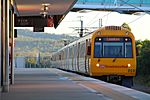 |
Electric multiple unit | 100 | 1994–1995 | 12 | City network (except Interurban services) | All 12 units have been updated between 2019 and 2024. |
| IMU100 |  |
Electric multiple unit | 140 | 1996–1997 | 10 | City network | All 10 units have been updated between 2019 and 2025. |
| SMU220 |  |
Electric multiple unit | 100 | 1999–2001 | 30 | City network (except Interurban services) | |
| IMU120 |  |
Electric multiple unit | 140 | 2001 | 4 | City network | |
| IMU160 | 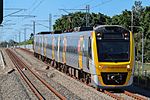 |
Electric multiple unit | 130 | 2006–2011 | 28 | City network | All units are being updated from 2022 onwards. |
| SMU260 |  |
Electric multiple unit | 130 | 2008–2011 | 36 | City network | All units are being updated from 2022 onwards. |
| NGR700 |  |
Electric multiple unit | 140 | 2015–2019 | 75 | City network (except Ferny Grove, Beenleigh & Rosewood) | |
| Former City Network Trains | |||||||
| EMU |  |
Electric multiple unit | 100 | 1979–1986 | 0 (June 2025) | City network (except Interurban services) | All EMU units have been retired as of June 2025. |
| ICE |  |
Electric multiple unit | 120 | 1988–1989 | 0 (November 2021) | City network | All ICE units have been retired as of November 2021. |
| Traveltrain Fleet | |||||||
| Electric Tilt Train |  |
Tilting electric multiple unit | 160 | 1997 | 2 | North Coast line | |
| Diesel Tilt Train |  |
Tilting push-pull train | 160 | 2003–2014 | 3 | North Coast line | |
| Locomotive Fleet | |||||||
| 1720 class |  |
Diesel locomotive | 100 | 1966–1970 | 8 Operational
4 Stored 1 Under overhaul |
Traveltrain services and infrastructure trains | These are often used for the Spirit of the Outback and Westlander trains. They are also the main engines for the Kuranda Scenic Railway. |
| 2150 class | Diesel locomotive | 100 | 1978–1979 | 1 Operational
2 Rebuilt |
Traveltrain services and infrastructure trains | ||
| 2170 class |  |
Diesel locomotive | 100 | 1982–1984 | 1 | Traveltrain services and infrastructure trains | |
| 2400 class |  |
Diesel locomotive | 100 | 1977–1978 | 4 Operational
1 Rebuilt |
Traveltrain services and infrastructure trains | |
| 2470 class |  |
Diesel locomotive | 100 | 1980–1983 | 5 Operational
1 Stored |
Traveltrain services and infrastructure trains | |
| 2900 class | Diesel locomotive | 100 | 2022-current | 4 Operational
1 Under construction 1 Planned |
Traveltrain services and infrastructure trains | These are rebuilt from other types of locomotives. | |
| Tourist Fleet | |||||||
| DL class |  |
Diesel locomotive | 50 | 1961 | 1 | Gulflander | DL4 is used as a backup for the Gulflander train. |
| 45 hp rail motor |  |
Railmotor | 40 | 1931 | 1 | Gulflander | RM60 is used for special trips. |
| 102 hp rail motor | 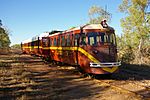 |
Railmotor | 50 | 1950 | 1 | Gulflander | RM93 is used for the weekly Gulflander service. |
| 1800 class |  |
Railmotor (trailers) | 50 | 1952–1954 | 2 | Gulflander | TP1809 is used as a trailer car on the Gulflander tourist railway. |
| Heritage Fleet (Old Trains) | |||||||
| A10 class |  |
Steam locomotive | 40 | 1865–1866 | 2 | No. 6 is working and is Australia's oldest working steam locomotive. No. 3 is being restored. | |
| B13 class | Steam locomotive | 50 | 1883–1895 | 1 | No. 48 is stored and waiting to be displayed. | ||
| B15 class | Steam locomotive | 65 | 1889–1899 | 1 | No. 290 is stored and waiting to be displayed. | ||
| PB15 class |  |
Steam locomotive | 65 | 1899–1926 | 2 | No. 732 is stored. No. 444 is on display at the Workshops Rail Museum. | |
| B13 1/2 class |  |
Steam locomotive | 50 | 1904–1905 | 1 | No. 398, known as 'Pompey', is stored. | |
| C17 class |  |
Steam locomotive | 80 | 1920–1953 | 3 | No. 974 is stored. No. 1000 is being restored. No. 2 is stored. | |
| C19 class | Steam locomotive | 80 | 1922–1935 | 1 | No. 700 is stored and waiting to be displayed. | ||
| B18¼ class | 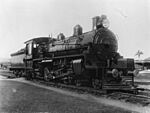 |
Steam locomotive | 80 | 1926–1947 | 1 | No. 771 is stored and waiting to be displayed. | |
| DL class |  |
Diesel locomotive | 50 | 1939 | 1 | On display at the North Ipswich Railway Workshops. This was Queensland's first diesel locomotive. | |
| AC16 class |  |
Steam locomotive | 80 | 1943 | 1 | No. 221A is working. | |
| DD17 class | 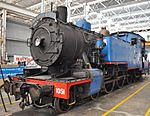 |
Steam locomotive | 80 | 1948–1952 | 1 | No. 1051 is being reassembled and repainted. | |
| Beyer-Garratt |  |
Steam locomotive | 80 | 1950–1951 | 1 | No. 1009 is on display at the Workshops Rail Museum. | |
| BB18¼ class | 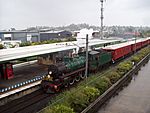 |
Steam locomotive | 80 | 1950–1958 | 2 | No. 1079 is working. No. 1089 is being repaired. | |
| 1150 class | Diesel locomotive | 80 | 1952 | 1 | 1159 is stored and waiting to be restored. | ||
| 1400 class | Diesel locomotive | 80 | 1955 | 1 | 1407 was sold to Mackay Steam Railway. | ||
| 1170 class | 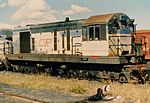 |
Diesel locomotive | 80 | 1956 | 1 | 1170 is stored and waiting to be restored. | |
| 1900 class |  |
Railmotor | 80 | 1956 | 1 | 1901 is working and used for tours. | |
| 2000 class |  |
Railmotor | 80 | 1956–1971 | 6 | 2034 and 2036 are working. 2057 is stored. | |
| 1450 class | Diesel locomotive | 80 | 1957 | 3 | 1450, 1455, and 1459 were sold to Mackay Steam Railway. | ||
| 1200 class | Diesel locomotive | 80 | 1953–1954 | 1 | 1200 is stored and waiting to be restored. | ||
| 1250 class | 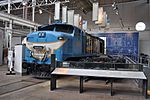 |
Diesel locomotive | 80 | 1959 | 2 | 1262 is on display at Workshops Rail Museum. 1263 is stored. | |
| SX carriages |  |
Passenger car | 80 | 1961–1962 | 7 | A set of 7 cars is stored. | |
| 1600 class |  |
Diesel locomotive | 80 | 1962 | 1 | 1603 is on display at Bundaberg Railway Museum. | |
| 1700 class | Diesel locomotive | 80 | 1963 | 1 | The cab of 1710 is used as a driving simulator at the Workshops Rail Museum. | ||
| 1460 class |  |
Diesel locomotive | 80 | 1964 | 1 | 1461 is waiting for mechanical repairs to be finished. | |
| 1270 class | 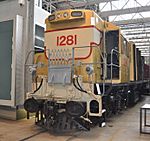 |
Diesel locomotive | 80 | 1964 | 2 | 1270 is stored. 1281 is on display at the Workshops Rail Museum. | |
| DH class |  |
Diesel locomotive | 50 | 1966 | 2 | DH2 is taken apart. DH71 is stored. | |
| 1620 class |  |
Diesel locomotive | 80 | 1967 | 3 | 1620 is stored. 1650 and 1651 are stored. | |
| Special Fleet | |||||||
| Vice-Regal Car | 80 | 1903 | 1 | Car 445 is a special train car used by the Governor of Queensland. It is on loan to the Workshops Rail Museum. | |||
This table only lists trains owned by Queensland Rail. Queensland Rail also sometimes rents trains from Aurizon.
Train Workshops
When Queensland Rail first started, its main workshops were the North Ipswich Railway Workshops. In the 1960s, these were replaced by the Redbank Railway Workshops. Today, the Mayne Yard rail area is where most repairs and maintenance of the trains happen.
Train Incidents
Here are some notable incidents involving Queensland Rail trains:
- On June 9, 1925, a train derailed near Traveston. Nine people died, and over 50 were hurt. Two train cars fell into Traveston Creek.
- On May 5, 1947, a crowded train crashed near Camp Mountain. This happened because it was going too fast down a hill and around a bend. Sixteen people died. This is still the worst accident in Queensland Rail's history in terms of lives lost.
- On February 25, 1960, a train called Midlander derailed near Bogantungan. Floodwaters had washed away part of a bridge. The train, carrying 120 passengers, fell into the creek. Seven people died, and 43 were injured. This is considered one of the worst accidents in QR's history.
- On March 23, 1985, two passenger trains crashed head-on near Trinder Park station. Two people died, including one driver, and 31 people were injured.
- On September 21, 2001, two electric trains collided with a cattle train near Petrie. Parts of the trains were badly damaged.
- On November 15, 2004, a Diesel Tilt Train derailed at Berajondo. This was due to going too fast. Over 100 people were injured.
- On September 14, 2012, an electric train collided with a large vehicle stuck on a railway crossing at Banyo. Both drivers were injured, and the train and vehicle were heavily damaged.
- On January 31, 2013, an electric train failed to stop at Cleveland station. It crashed into the station's toilet block. The train was badly damaged, and some passengers and staff had minor injuries.
- On June 18, 2021, a Queensland Rail training train collided with a loaded coal train at Westwood. This happened west of Rockhampton. Two drivers on the Queensland Rail train were injured, and one person died.
See also
 In Spanish: Ferrocarriles de Queensland para niños
In Spanish: Ferrocarriles de Queensland para niños
- Rail transport in Queensland
- Aurizon


